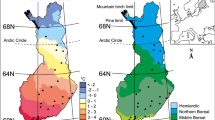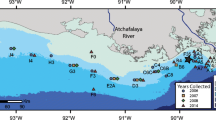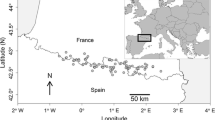Abstract
In a survey of 35 high arctic ponds, chrysophycean cysts were relatively more common in moss periphyton and epilithon habitats, than in surface sediment samples. The highest percentages of cysts relative to diatoms were found in the semi-aquatic mosses. Although chrysophytes are generally considered to be planktonic, periphytic taxa may be common in high latitudes. The ratio of diatom frustules to chrysophyte cysts in arctic sediment cores may be tracking different environmental variables than paleolimnologists may intuitively expect based on observations from more temperate regions.
Similar content being viewed by others
References
Battarbee, R. W., 1986. Diatom analysis, In Berglund, B. E. (ed.), Handbook of Holocene Palaeocology and Palaeohydrology, John Wiley & Sons, Toronto: 527–570.
Bridgland, J. P., 1986. The flora and vegetation of Cape Herschel, Ellesmere Island, N.W.T. M.Sc. Thesis, Memorial University, St. John's, Newfoundland, 125 pp.
Brown, K. M., M. S. V. Douglas & J. P. Smol, 1994. Siliceous microfossils in a Holocene, high arctic peat deposit (Nordvestø, northwestern Greenland). Can. J. Bot. 72: 208–216.
Cronberg, G., 1986. Chrysophycean cysts and scales in lake sediments: a review. In J. Kristiansen & R. Andersen (eds.), Chrysophytes: Aspects and Problems, Cambridge University Press, Cambridge: 281–315.
Cumming, B. F., S. E. Wilson & J. P. Smol, 1993. Paleolimnological potential of chrysophyte cysts and scales, and sponge spicules as indicators of lakewater salinity. Int. J. Salt Lake Research 2: 87–92.
Douglas, M. S. V., 1989. Taxonomic and ecological characterization of freshwater diatoms from the sediments of 36 high arctic ponds (Cape Herschel, Ellesmere Island, N.W.T., Canada). M.Sc. Thesis, Queen's University, Kingston, Ontario, 172 pp.
Douglas, M. S. V., 1993. Diatom ecology and paleolimnology of high arctic ponds. Ph. D. Thesis, Queen's University, Kingston, Ontario, 164 pp.
Douglas, M. S. V. & J. P. Smol, 1993. Freshwater diatoms from high arctic ponds (Cape Herschel, Ellesmere Island, N.W.T.). Nova Hedwigia 57: 511–552.
Douglas, M. S. V. & J. P. Smol, 1994a. Limnology of high arctic ponds (Cape Herschel, Ellesmere Island, N.W.T.). Arch. Hydrobiologie (in press).
Douglas, M. S. V. & J. P. Smol, 1994b. Periphytic diatom assemblages from high arctic ponds. J. Phycology (in press).
Duff, K. E. & J. P. Smol, 1988. Chrysophycean stomatocysts from the postglacial sediments of a high arctic lake. Can. J. Bot. 66: 1112–1128.
Duff, K. E. & J. P. Smol, 1989. Chrysophycean stomatocysts from the postglacial sediments of Tasikutaaq Lake, Baffin Island, N.W.T. Can. J. Bot. 67: 1649–1656.
Duff, K., M. S. V. Douglas & J. P. Smol, 1992. Chrysophyte cysts from 36 high arctic ponds. Nordic J. Bot. 12: 471–499.
Duff, K., B. Zeeb & J. P. Smol, 1994. Atlas of Chrysophycean Cysts, Kluwer Academic Publishers, Dordrecht, 189 pp.
Engstrom, D. R., C. Whitlock, S. C. Fritz & H. E. Wright, Jr., 1991. Recent environmental changes inferred from the sediments of small lakes in Yellowstone's northern range. J. Paleolimnol. 5: 139–174.
Hickman, M. & C. E. Schweger, 1991. A palaeoenvironmental study of Fairfax Lake, a small lake situated in the Rocky Mountain Foothills of west-central Alberta. J. Paleolimnol. 6: 1–15.
Hilliard, D. K. & B. Asmund, 1963. Studies on Chrysophyceae from some ponds and lakes in Alaska. II. Notes on the generaDinobryon, Hyalobryon andEpipyxis with descriptions of new species. Hydrobiologia 22: 331–397.
Moore, J. W., 1979. Factors influencing the diversity, species composition and abundance of phytoplankton in twenty one Arctic and subarctic lakes. Int. Revue Gesamten Hydrobiol. 64: 485–497.
Nogrady, T. & J. P. Smol, 1989. Rotifers from five high arctic ponds, Cape Herschel, Ellesmere Island. Hydrobiologia 173: 231–242.
Risberg, J. 1990. Siliceous microfossil stratigraphy in a superficial sediment core from the northern part of the Baltic proper. Ambio 19: 167–172.
Sheath, R. G., 1986. Seasonality of phytoplankton in northern tundra ponds. Hydrobiologia 138: 75–83.
Smol, J. P., 1983. Paleophycology of a high arctic lake near Cape Herschel, Ellesmere Island. Can J. Bot. 61: 2195–2204.
Smol, J. P., 1985. The ratio of diatom frustules to chrysophycean statospores: a useful paleolimnological index. Hydrobiologia 123: 199–208.
Smol, J. P., 1988. Chrysophycean microfossils in paleolimnological studies. Palaeogeog. Palaeoclim. Palaeoecol, 62: 287–297.
Smol, J. P., 1990 Diatoms and chrysophytes — a useful combination in paleolimnological studies. In: Simola, H. (ed.), Proceedings of the 10th International Diatom Symposium. Koeltz Scientific Books, Koenigstein: 585–592.
Smol, J. P., 1994. Application of chrysophytes to problems in paleoecology. In: C. Sandgren, J. P. Smol & J. Kristiansen [eds.]. Chrysophyte Algae: Ecology, Phylogeny and Development Cambridge University Press, Cambridge (in press).
Stoermer, E. F., J. P. Kociolek, C. L. Schelske & N. A. Andresen, 1991. Siliceous microfossil succession in the recent history of Green Bay, Lake Michigan. J. Paleolimnol. 6: 123–140.
Wallen, D. G. & R. Allen, 1982. Variations in phytoplankton communities in Canadian arctic ponds. Nat. Can. 109: 213–221.
Yang, J-R., H. C. Duthie & L. D. Delorme, 1993. Reconstruction of the recent environmental history of Hamilton Harbour (Lake Ontario, Canada) from analysis of siliceous microfossils. J. Great Lakes Res. 19: 55–71.
Zeeb, B. A. & J. P. Smol, 1993. Postglacial chrysophycean cyst record from Elk Lake, Minnesota. In: J. P. Bradbury & W. Dean (eds.), Elk Lake, Minnesota: Evidence for Rapid Climate Change in the North-Central United States. Geological Society of America Special Paper 276: 239–249.
Author information
Authors and Affiliations
Rights and permissions
About this article
Cite this article
Douglas, M.S.V., Smol, J.P. Paleolimnological significance of observed distribution patterns of chrysophyte cysts in arctic pond environments. J Paleolimnol 13, 79–83 (1995). https://doi.org/10.1007/BF00678112
Received:
Accepted:
Issue Date:
DOI: https://doi.org/10.1007/BF00678112




